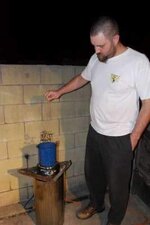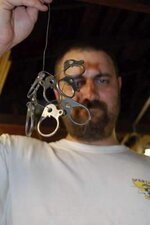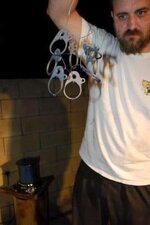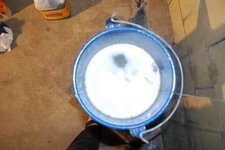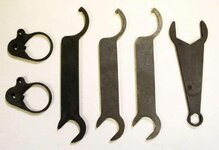- Messages
- 2,948
- Reactions
- 2,214
So I have been needing to do some parkerizing for a while for a bunch of parts for my business. I sent the job out for quotes to 3 different places locally, and no one got back to me. Maybe I smell funny or something, I dunno. But their loss is my gain.
After doing a fair amount of reading online about what it takes, I decided to take the plunge and do it myself.
I started out with a trip to my local home depot, and after asking for "Jasco Prep and Prime" (what most home parkers use) I was directed to another product called "Klean strip Phosphoric Prep & Etch" which comes in a 1 gallon bottle for $14. It's an angry green color.
I setup my park tank, a 1-gallon camp enameled cooking pot and put it on top of my hotplate out in the back yard. At first I added about 60mL (yes, mL, I used a graduated cylinder) to 2L of water. And then added some Manganese Dioxide I took out of a new carbon-zinc (usually labeled "Heavy Duty") D cell. I added about half a tablespoon of the MnO2. I then set the hot plate to warm it up to 90C and waited for it to heat up. While parking the first batch of parts bubbling was going slow, so I added another 60mL of acid to the solution.
I parked a few parts, usually simply waiting until the parts came out the black color I was looking for, washed them in clean water, and then covered them in hoppes. Results were good.
For the second batch, I was a little sloppy with my measuring and added way more acid. The parts came out looking horrible.
So now I'm on the third batch, and the parts are looking great, deep black colors all around. I had the girlfriend take some pictures, which I'll upload a bit later. The final solution I came up with is this:
1 Tblspoon MnO2
130ml Phosphoric acid (the product mentioned earlier)
2L distilled water
Add about 1/2 of a muffin of degreased (with brake cleaner) steel wool when the solution is at temperature, once it dissolves it's time to start parking.
A few observations: The parts I'm working with are lasercuts, they have been stuck in the rotary tumbler and dehorned and deburred. They were sitting in water soluable oil to keep them from rusting while I waited to get the chemicals. When I pulled them out of the tray with the oil, I sprayed them down with purple power (a degreaser availible at autozone) and then rinsed in hot water. I then connected all the parts together with wires (they are small parts) and sprayed them down with brake cleaner. I would then hang them up for a few minutes to dry, make sure the water level was right in the tank, and then dip them. Bubbling is intense for the first few minutes and will then level off. I usually check the parts after about 10 minutes, and I will usually let them go for another 5-10 minutes checking periodically to see how the finish is coming out. Once they achieve the desired level of blackness I pull them out. If they sit until it stops bubbling (like most people say) they usually come out more of a gunmetal grey color, and not a deep charcoal black.
After you pull the parts out of the solution, wash them with clean water, and immediately spray them with oil. I highly recommend using a spray type oil, like rem oil, WD40, or something similar. Alternatively, you could have a dip tank. Since I have neither, and am using a hoppes soaked rag, it's kinda've a pain to get them all covered right away.
So that's it. I'll post some pics later.
After doing a fair amount of reading online about what it takes, I decided to take the plunge and do it myself.
I started out with a trip to my local home depot, and after asking for "Jasco Prep and Prime" (what most home parkers use) I was directed to another product called "Klean strip Phosphoric Prep & Etch" which comes in a 1 gallon bottle for $14. It's an angry green color.
I setup my park tank, a 1-gallon camp enameled cooking pot and put it on top of my hotplate out in the back yard. At first I added about 60mL (yes, mL, I used a graduated cylinder) to 2L of water. And then added some Manganese Dioxide I took out of a new carbon-zinc (usually labeled "Heavy Duty") D cell. I added about half a tablespoon of the MnO2. I then set the hot plate to warm it up to 90C and waited for it to heat up. While parking the first batch of parts bubbling was going slow, so I added another 60mL of acid to the solution.
I parked a few parts, usually simply waiting until the parts came out the black color I was looking for, washed them in clean water, and then covered them in hoppes. Results were good.
For the second batch, I was a little sloppy with my measuring and added way more acid. The parts came out looking horrible.
So now I'm on the third batch, and the parts are looking great, deep black colors all around. I had the girlfriend take some pictures, which I'll upload a bit later. The final solution I came up with is this:
1 Tblspoon MnO2
130ml Phosphoric acid (the product mentioned earlier)
2L distilled water
Add about 1/2 of a muffin of degreased (with brake cleaner) steel wool when the solution is at temperature, once it dissolves it's time to start parking.
A few observations: The parts I'm working with are lasercuts, they have been stuck in the rotary tumbler and dehorned and deburred. They were sitting in water soluable oil to keep them from rusting while I waited to get the chemicals. When I pulled them out of the tray with the oil, I sprayed them down with purple power (a degreaser availible at autozone) and then rinsed in hot water. I then connected all the parts together with wires (they are small parts) and sprayed them down with brake cleaner. I would then hang them up for a few minutes to dry, make sure the water level was right in the tank, and then dip them. Bubbling is intense for the first few minutes and will then level off. I usually check the parts after about 10 minutes, and I will usually let them go for another 5-10 minutes checking periodically to see how the finish is coming out. Once they achieve the desired level of blackness I pull them out. If they sit until it stops bubbling (like most people say) they usually come out more of a gunmetal grey color, and not a deep charcoal black.
After you pull the parts out of the solution, wash them with clean water, and immediately spray them with oil. I highly recommend using a spray type oil, like rem oil, WD40, or something similar. Alternatively, you could have a dip tank. Since I have neither, and am using a hoppes soaked rag, it's kinda've a pain to get them all covered right away.
So that's it. I'll post some pics later.






